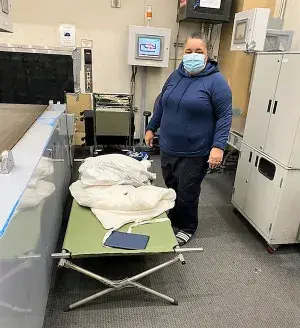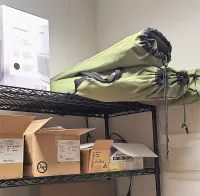
The massive winter storm that paralyzed much of the South in February had a huge impact on TSA officers in the region and will continue to have a big impact for some time to come.
The storm knocked out power to millions of Texas homes and damaged the homes of numerous TSA employees, but Houston’s George Bush Intercontinental Airport (IAH) TSA Coordination Center Manager Stacy Curvey said IAH team members weathered the storm. Several TSA officers decided to stay at the airport’s Coordination Center to receive and distribute information to employees, and their decision to step up to the plate provided much needed relief to the workforce.
Coordination centers keep a close eye on our airports and possible threats by gathering, analyzing and evaluating data inside and outside airports.
“During the crisis, we received approximately 1,000 unscheduled callouts at the single IAH callout phone number established for the workforce during the five-day ordeal,” said Curvey. “The team worked together to see what, if any, issue [TSA employees] may be experiencing due to the storm and if [our team] could help in any way.”
Forty TSA officers and two managers also volunteered for what’s called the IAH Ride Out Team (ROT). Their mission is to respond to major incidents or natural disasters by augmenting their staff and assisting with the security mission. This time, they also helped the Coordination Center answer phone calls and enter data.
“When activated, ROT members report for duty within a predetermined period of time and should anticipate remaining on airport property until released by the federal security director or designee,” explained TSA Manager Amie Corchado, who oversees the IAH Ride Out Team. “Members of this team must be willing to respond on short notice for details lasting up to 15 days.”
“It is never an easy decision to leave your home or family during times of crisis or natural disaster, but that is exactly what our officers do to support the mission,” Corchado said. “The hard work and dedication is absolutely outstanding!”
TSA Supervisory Coordination Center Officer Latoshia Waobikeze took the risk of sliding her way to the airport during the storm. “When I finally arrived to the airport after sliding on the glassy road, I noticed two Coordination Center officers taking turns sleeping on cots in the office while working 12-hour shifts because they couldn’t go home,” Waobikeze said. “It was such a tragedy to hear my 82-year-old grandma was freezing after going more than two days without power, and we couldn’t reach her.”
Waobikeze said commuting was nearly impossible since the city of Houston doesn’t have the proper equipment to treat streets and bridges, and the airport became a “ghost town.” She said the callouts and questions continued to flow through the Coordination Center along with no power and no water. Her team had to rely on bottled emergency water and MREs (meals ready to eat).
Corchado said ROT was activated for five days, supporting operations with screening to make sure passengers who were able to get to the airport and secure flights got on their way safely.
“After five years here, I have never seen this impact so many people,” said TSA Manager Patrick Peralta, supporting Operations Manager for ROT. “Part of the Ride Out Team is to hunker down and take care of operations until our people can come back. We worked 16-hour days for five days, sleeping on cots or in our cars until the roads were clear enough for our folks to return.”
Unfortunately, the storm left lasting effects on numerous IAH TSA officers and their families.
“Damaged homes due to frozen pipes, causing them to burst, creating numerous plumbing issues,” noted Curvey.
“Some are still trying to recover their homes, working with neighbors to rebuild their homes that were destroyed from busted water pipes,” Waobikeze added. “Some experienced damage to their personal items from the water damage as well as food shortages from going days without power. Some are still affected today and unable to return to work.”
Houston TSA Federal Security Director Juan M. Sanchez is amazed by his workforce’s resilience, saying, “We have been through plenty of storms, been impacted by several hurricanes, and our team dealt with the sub-freezing temps of February 2021 head-on. I think most would have enjoyed the joys of snow and the cold weather. However, no one told us we would be without power for an extended period of time and many others without water as well. It was horrible! This team has just about seen it all, and I am constantly reminded how resilient our workforce is. I am proud to serve alongside them.”



